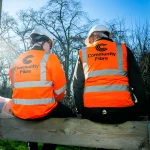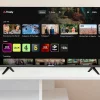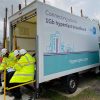Ofcom Spring 2023 Study – Gigabit Broadband Covers 73% of UK

Ofcom’s Spring 2023 report into UK fixed line broadband and mobile coverage has found that “full fibre” (FTTP) now reaches 48% of the UK (up from 42% in Sept 2022), while 73% are within reach of a gigabit-capable network (up from 70%) and 73-82% of premises can get outdoor 5G cover from at least one operator (up from 67-78%).
The regulator’s latest report is based on coverage and service availability information that has been received from both fixed line UK ISPs and mobile network operators as of January 2023, which is thus several months more recent than the September 2022 data in their last Connected Nations 2022 report (here).
Since the last report, the UK coverage of fixed “superfast broadband” (30Mbps+) networks has remained unchanged on 97%, while 14.2 million homes (48%) can now order a Fibre-to-the-Premises (FTTP) service via various networks (up from 42% at the last update). But Ofcom notes that full fibre coverage has since exceeded the 50% figure in March 2023, which obviously won’t be reflected by today’s older data.
Advertisement
Meanwhile, gigabit-capable (1Gbps+) services are now available to 73% of the UK or 21.9 million premises (up from 70%), which is higher than the FTTP figure because most of the gigabit connectivity has flowed from Virgin Media’s upgrade to their existing Hybrid Fibre Coax (HFC) network with DOCSIS 3.1 technology (there’s a lot of overbuild between HFC and FTTP in dense urban areas).
All of this work should help to support the UK Government’s new £5bn Project Gigabit programme, which aims to further improve the picture for gigabit speed connectivity by using state aid to target connectivity improvements toward the final 20% of hardest to reach premises (i.e. helping to extend gigabit coverage to at least 85% of UK premises by the end of 2025 and then around 99% “nationwide” by 2030).
However, the number of premises that cannot get a “decent broadband” (10Mbps+) service is currently 435,000 (around 1.4% of the UK), which shrinks to just 68,000 (down from 83k before) if you include delivery via wireless connections (i.e. 4G, 5G and fixed wireless access). A download of at least 10Mbps (1Mbps upload) also represents the core specification for the UK Government’s broadband Universal Service Obligation (USO).
Speaking of wireless services, 4G mobile networks have seen geographic coverage across all network operators (EE, Three UK, O2 and Vodafone) hold steady at a range of 80-87%. The new £1bn Shared Rural Network (SRN) agreement will eventually start to change that, but it’s a very slow burn.
Advertisement
Finally, on 5G coverage, Ofcom states that some 73-82% of UK premises can now get outdoor coverage by at least one operator (up from 67-78%), but this collapses to just 12-22% when looking at outdoor coverage by all operators combined (up slightly from 11-20%). Suffice to say, there’s a long way to go in order to extend 5G into areas outside of larger towns and cities.
Spring 2023 Coverage Data by Region
The following table summarises the latest mobile and fixed broadband coverage figures for Scotland, Wales, England and Northern Ireland individually, although you can get a bit more detail by downloading the full Spring 2023 Update (PDF).

Mark is a professional technology writer, IT consultant and computer engineer from Dorset (England), he also founded ISPreview in 1999 and enjoys analysing the latest telecoms and broadband developments. Find me on X (Twitter), Mastodon, Facebook, BlueSky, Threads.net and Linkedin.
« Freedom Fibre Reopens UK Community Fund with £500 Grants























































Amazing progress
Interesting that USO has made progress, especially in NI but Superfast hasn’t. Good news of course, but feels like people in between these metrics are being left behind.
I suspect it’s because they’re including 4G and the SRN is starting to have a bigger impact now.
That would make sense, thanks Mark 🙂
Very misleading. A gigabit network is 1Gbps up and 1Gbps down, Virgin Media is a pathetic 0.05Gbps up.
Well it’s not misleading because your definition isn’t the definition they use
The definition they use produces the results that make the government look better than the travesty that Gigabit broadband is, in reality.
Gigabit Ethernet is symmetrical. They didn’t say anything about Gigabit Ethernet. I’m not sure why this is suddenly such an issue given we had a 24:1 ratio with ADSL, 4:1 with VDSL and cable has often been a lot worse than the current 10:1/20:1.
Usage has skewed more towards download and away from upload over time:
https://itif.org/publications/2021/05/12/broadband-myth-series-do-we-need-symmetrical-upload-and-download-speeds/
So changing the definition now for broadband/Internet access to requiring symmetrical doesn’t make a lot of sense.
Maybe because a number of the non-monoply “niche” players have shown that it’s both technically and arguably financially viable to provide true symmetric connections for the same price? That strongly suggests consumers have been severely short changed paying more or the same for less. In fact some might go so far as to suggest non-symmetric connections are just another way for monopolistic providers like Virgin and BT to give us less for more.
I read that report, it’s interesting but is heavily based on todays use case which is where it’s utterly flawed. After 30 or so years, the use cases today are likely a consequence of the asymmetric nature of the connection and not indicative of the use cases that may exist if it were symmetrical. But even if TRUE symmetrical connections don’t make sense, I’d argue neither do 14:1 or higher ratios. Who knows what use we’d put symmetrical connections to had they been the norm for the past 30 years.
Without disappearing down an anti capitalist tin foil hat rabbit hole we’ve moved a long long way from the early ideals of the Internet where everyone was going to be a content provider. A lot of that is because there’s no money for the capitalists in that. There’s no ability for the elites to drive or control the narrative if they don’t control it. As a result EVERYTHING is designed to turn us into consumers and that includes ensuring that if we want to distribute anything on mass, we need to do it through a system someone else controls. I get it, that boat has sailed, but it was nice in the late 90’s when that was still a hope…
Virgin Media’s cable network is, by design, heavily asymmetric and to make it symmetrical is what they’re doing, and involves fibre over all the coax or £1.5 billion of hybrid fibre-coax upgrade. People could certainly say that they’re selling asymmetric tiers to get more money for less but they’re wrong.
Don’t get me wrong: that report was written with an agenda but it doesn’t change the facts. We can look at the numbers from Singapore and others that’ve had symmetrical for years and the numbers don’t really change. The major upload app was torrents, they’ve given way to streaming from YouTube, Netflix, etc, and the ratios are more skewed.
This lack of change follows on from customers not suddenly consuming 10 times as much data downstream if they move from 100 Mbit to a gigabit: they do the same things just quicker.
Openreach don’t really save any money or provide ‘less’. The only real reason they have to offer the upload they do is to try and ensure businesses don’t move from leased lines / DIA to FTTP. Offering way more upload would cost them, in terms of delivering it, nothing.
The majority of upload usage comes from a tiny segment of the userbase. It’s way more skewed than downstream usage. We’re by default content consumers from many places and no household can create more content than they consume simply because consuming content is watching it for the duration, creating is a lot more time intensive.
Even a Discord or Zoom call you’re sending a stream and receiving several: compression aside you’re receiving more content than you’re producing.
There are some presentations where ISPs discuss the ratios on their networks scattered around.
Again don’t get me wrong: Openreach have no legitimate technical reason to sell FTTP as asymmetrical as they do, all about the commercial case, and I love my symmetrical service.
73% coverage is a travesty? Christ.
Access to fibre has increased by 11 percentage points but access to gigabit speeds only by 5. That suggests the fibre rollouts are not well targetted to the areas that will benefit the most.
They are targeted to the areas the people building the networks think will benefit them the most.
Well, that’s because both sides of politics have opted for private sector investment that’s “market led”. As a company you’ll always get better returns and have lower cost from the densest network uptake, so you’ll prioritise those unless there’s other factors that put the cost up (eg a notably uncooperative council, or a medieval town where you have to stop digging every five feet for achaeologists to fuss over a broken pot etc). MDU’s can fall into either the easy to do, high density category, or the hard to do and expensive category depending entirely on the landlord.
We tried national provision by the state, that was poor. We’ve tried private provision, regulated by the state, and that’s exceptionally patchy, and over recent years has also tended to be poor (esp rail, energy). Better ideas for how to manage the system are welcome I’m sure.
Maybe national provision by the state was deliberately poor because the folks in charge couldn’t syphon the funding to themselves easy enough?
@buggerlugz and THERE’S the truth. So many people don’t want to believe or don’t care our elected officials are only in it to line their own pockets. They don’t believe that they wouldn’t shaft over millions of people for billions of pounds. Just sickens me.
@mike: What are you talking about? You say “Access to fibre has increased by 11 percentage points but access to gigabit speeds only by 5” but the actual figures are 6 and 3 respectively. Furthermore access to a gigabit-capable network includes the 14.3m premises of Virgin Media which are on the HFC network and this network is not being made bigger as it is being replaced by fibre.
I would like a clear understanding of what the 73% means. Eg that 73% of people can order and obtain gigabit connection? Or is it that 73% have had cabling run along their street – but can’t actually subscribe to a gigabit connection. I suspect its the latter using the words that have clearly been carefully chosen. In the same vein as when Nadine Dories said similar. Saying your in reach of it doesn’t mean you can have it.
@Richard Smart: You suspect wrong. Access means what it says on the tin.
I’ve said it before on similar articles but those mobile coverage figures are a complete lie. I live in a town of 10,000+ people but can only get <8Mb 4G from EE or 3. Vodafone and O2 state support on the maps (as does ofcom) but they just don't work inside (and patchy outside). I only need travel a few miles and I can lose all signal too. Not spots are under estimated and there is no way to complain to ofcom that their own maps are wrong. I've had energy firms refuse to install smart meters without an external aerial but they just check the maps before hand and always end up surprised.
(I don't think it helps I am in the shadow of a hill with a 4g station on top but just slightly on the other side of the ridge – I suspect if I stuck my phone on a 20M poll I'd have excellent signal.)